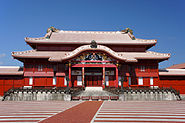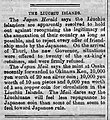Ryukyu Disposition

The Ryukyu Disposition (琉球処分, Ryūkyū shobun),[2][3] also called the Ryukyu Annexation (琉球併合, Ryūkyū heigō)[4][5][6] or the annexation of Okinawa,[7][8] was the political process during the early years of the Meiji period that saw the incorporation of the former Ryukyu Kingdom into the Empire of Japan as Okinawa Prefecture (i.e., one of Japan's "home" prefectures) and its decoupling from the Chinese tributary system.[9][10] These processes began with the creation of Ryukyu Domain in 1872 and culminated in the kingdom's annexation and final dissolution in 1879; immediate diplomatic fallout and consequent negotiations with Qing China, brokered by Ulysses S. Grant, effectively came to an end late the following year.[1][11] The term is also sometimes used more narrowly in relation to the events and changes of 1879 alone.[12] The Ryūkyū Disposition has been "alternatively characterized as aggression, annexation, national unification, or internal reform".[9]
Background
| History of Ryukyu |
|---|
  |
| Militarism | |
|---|---|
| Battle of Okinawa | 1945 |
| Military Government | 1945–1950 |
|---|---|
| Civil Administration | 1950–1972 |
| Government | 1952–1972 |
| Tokara Reversion | 1952 |
| Amami Reversion | 1953 |
| Koza riot | 1970 |
| Okinawa Reversion Agreement | 1971 |
| Okinawa Reversion | 1972 |
| Kagoshima Prefecture | 1953–present |
|---|
Early in the
The years following the Meiji Restoration of 1868 saw not only the abolition of the han system (Ryūkyū subject for the time being to the jurisdiction of Kagoshima Prefecture) but also efforts to "consolidate" the borders of the new nation state.[1][12] With the Mudan incident, the massacre of dozens of shipwrecked Ryūkyūans (from the Miyako Islands) in Qing-ruled Taiwan in 1871, the "Ryūkyū problem" was brought to the fore.[1][12] In May the following year, negotiations with China over the incident still ongoing, Vice Treasury Minister Inoue Kaoru proposed annexation of the Ryūkyūs, arguing that they had long been subordinate to Satsuma, and that their "return to Japanese jurisdiction" would allow for a "single system for the homeland".[8][11]
Disposition
In the New Year of 1872,
In May 1874, Japan launched a punitive expedition against Taiwan; Britain acting as mediator, in the peace settlement of 31 October that year, China not only agreed to pay an indemnity but also referred to the Ryūkyūans as "subjects of Japan" (日本国属民), a fact described the following year by Gustave Boissonade as "the happiest outcome of the treaty".[8][11][12] Meanwhile, on 12 July 1874, responsibility for the Ryūkyūs was transferred from the Ministry of Foreign Affairs to the Home Ministry.[8] In November 1874, the Ryūkyū government sent a tributary mission to China, drawing criticism from Home Minister Ōkubo Toshimichi, who set out in a report of enquiry a number of steps to be taken to address the Ryūkyū Domain's adherence to "ancient outdated laws" and failure to see "reason", while senior Domain officials were summonsed to Tōkyō.[8]
In March 1875, the Japanese government decided upon the "disposition" of the domain.
In September 1876, a barracks was completed near the port of Naha and twenty-five soldiers from the Kumamoto garrison installed.[8] Three months later, the Ryūkyū Domain sent a secret mission to China, where they drew attention to Japanese interference in their tributary missions.[8] In 1878, Chinese diplomat He Ruzhang would meet twice with Minister of Foreign Affairs Terashima Munenori to complain of the end to diplomatic relations with Ryūkyū.[8] A few months earlier, Ryūkyū representatives in Tōkyō sent secret letters to their US, French, and Dutch counterparts to complain of Japan's treatment and attempt to secure assistance.[8][15] Some fourteen petitions were also submitted to the Japanese government, requesting a return to the old system of dual allegiance, arguing that "Japan is our father, China our mother", but meeting with the response that "to serve two emperors is like a wife serving two husbands".[15] At the close of the year, Home Minister Itō Hirobumi having taken the decision to replace the domain with a prefecture, Ryūkyū officials were expelled from Tōkyō and their official residence in the city closed.[8][15]

In January 1879,
As Smits notes, however, the "issue of Ryukyuan sovereignty ... was not yet settled in the international arena".[11] With the Qing government vehemently protesting the annexation, spurred on by hawks advocating armed resolution, the Ryūkyū question became an important contributing factor in the build up to the First Sino-Japanese War.[12] At the urging of Li Hongzhang, and after mediation by visiting former US President Ulysses S. Grant, in 1880 Japan entered into negotiations with China.[11][12] Both sides proposed to divide the Ryūkyūs: Japan offered to hand over some of its home territory, in the form of the Yaeyama Islands and Miyako Islands, in return for revision of the Sino-Japanese Friendship and Trade Treaty, whereby Japan might trade in the interior of China and be accorded most favoured nation status; the Chinese proposed Amami Ōshima and the surrounding islands go to Japan, Okinawa to the Ryūkyū King, and the Yaeyama and Miyako Islands to China, which would then restore them to the Ryūkyū King.[11][12] Negotiations reached an advanced stage, but at the end of the year China refused to ratify the agreement and the status quo continued.[11][16] Meanwhile, in its "Memorandum of Japan's sovereign rights to the Ryūkyū Islands, in response to the Chinese government's protest", the Meiji government advanced a number of factors in support of the legitimacy of its claims, citing geographic, historic, racial, linguistic, religious, and cultural propinquity, and stated that, with the abolition of the han, Ryūkyū was the final domestic territory to be reformed and brought under centralized government control.[1] Within Okinawa itself, Japan's victory in the First Sino-Japanese War brought any lingering discontent to an end.[12]
Legacy of the term
After the war, the term Ryūkyū shobun saw reuse in relation to the status of the Ryūkyūs per Article 3 of the
Related images and articles
-
Disposition Officer Matsuda Michiyuki
-
Shō Tai, last king of the Ryukyu Kingdom
-
Front page of the Yomiuri Shimbun on 5 April 1879, announcing the abolition of Ryukyu Domain and establishment of Okinawa Prefecture
-
10 October 1879 edition ofThe North China Herald, reporting on Japan's "claim" to the Liuchiu Islands
-
Continuation of the same, with a reference to the Mudan incident
-
"The Liuchiuan Question According to the Japanese Point of View", in the same
-
Continuation, with translations of the oaths of Shō Nei and the Sanshikan and of the Fifteen Injunctions (following the 1609 invasion)
-
Update inThe North China Heraldone week later
See also
- Hokkaidō Development Commission
- Okinawa Shrine
- Ryukyu independence movement
- Ryukyuan assimilation policies
- Sakishima Beacons
References
- ^ ISBN 978-0739182482.
- ^ "Okinawa: History (The Birth of Okinawa Prefecture/World War II/Post World War II Okinawa to the Present)". Ministry of Foreign Affairs. Retrieved 5 August 2020.
- Kinokuniya. pp. 61–62.
- ^ 琉球王国の歴史的事実と認識に関する質問主意書. Official site of the House of Representatives (in Japanese).
- ^ 琉球併合は「国際法違反」 独立学会、日本政府に謝罪要求 (in Japanese). Ryūkyū Shimpō. February 4, 2015.
- ^ "The Ryukyu Annexation in Modern East Asian History". 14 November 2019.
- S2CID 144934970.
- ^ S2CID 144934970. Retrieved 18 June 2021.
- ^ ISBN 9780190697570. Retrieved 18 June 2021 – via Google Books.
- ^ a b 琉球処分 [Ryūkyū Shobun]. Kokushi Daijiten (in Japanese). Yoshikawa Kōbunkan 吉川弘文館. 1979–1997.
- ^ ISBN 0-8248-2037-1.
- ^ Shōgakukan. 2001.
- ^ "Introduction of Okinawa". Okinawa Prefecture. Retrieved 5 August 2020.
- ^ ISBN 978-1462901845.
- ^ ISBN 978-0231123402.
- ^ 琉球処分 [Ryūkyū Shobun]. Ryūkyū Shimpō (in Japanese). 1 March 2003. Retrieved 5 September 2020.









